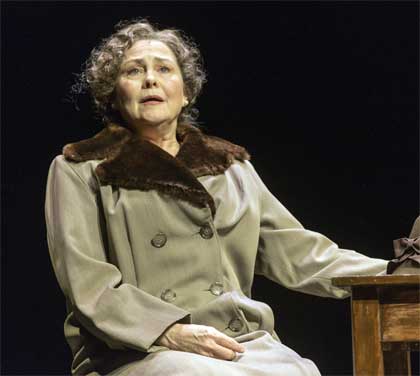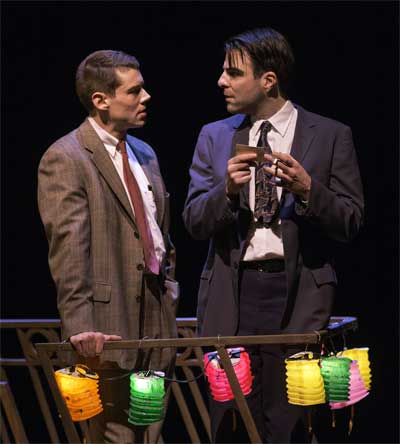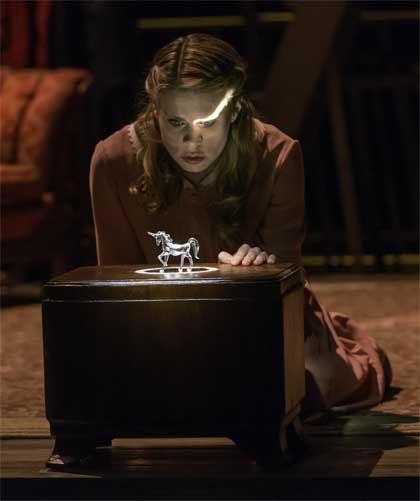Play (1944)
by Tennessee Williams
Directed by John Tiffany
American Repertory Theatre
Cambridge, MA
February 2 – March 17, 2013
Set and Costume Design: Bob Crowley, Lighting Design: Natasha Katz, Sound Design: Clive Goodwin, Music Nico Muhly, Dialect Coach: Nancy Houfek, Movement: Steven Hoggett
With Zachary Quinto (Tom), Cherry Jones (Amanda), Celia Keenan-Bolger (Laura), Brian J. Smith (The Gentleman Caller)

in “The Glass Menagerie”
Photo by Michael J. Lutch
Courtesy American Repertory Theatre
Introduced at the outset by Tom (Zachary Quinto) as a vehicle of memory, the captured scenes that ensue in this play reveal a family caught in an emotional vise. Tom and his sister, Laura, are twenty-something children of Amanda, a domineering single mother who raised them after her husband abandoned the family years before. Desperately wishing to find a mate for the painfully shy and reclusive Laura, Amanda enlists Tom to bring home a fellow worker as an unsuspecting gentleman caller.
The Glass Menagerie is told from the perspective of Tom, a close stand-in for Thomas “Tom” Lanier Williams, aka Tennessee Williams, and represents an accounting of the psychological fuel that eventually gives rise to his life as a writer. Williams’ care in the beginning to have Tom tell us that this is not mere naturalism but the evocation of memory yields a play that is like a family portrait etched in sepia rather than a documentary account.

Zachary Quinto as Tom
in “The Glass Menagerie”
Photo by Michael J. Lutch
Courtesy American Repertory Theatre
Alternating episodes of delicacy and brutality unfold within this family’s complex dynamics to create a play punctuated by striking dramatic rhythms.
Amanda’s forceful, domineering and narcissistic personality is appalling, but, especially in Cherry Jones’ deft hands, is exerted with the kind of leverage that makes it emotionally complex. For her, hope for Laura’s future arises at every turn and is squashed soon thereafter not only by the turn of events but by the insidious logic of Amanda’s own psychology.
This subtle dance between the rising of hope and its decline affects each character in turn. Amanda speaks the loudest and her disappointment echoes widely, but Laura, Jim, and Tom all experience this arising and decline, making the play’s emotional rhythm complex and interesting.
Cherry Jones (Amanda) is a powerful presence and exerts her influence with a commonsense rationality that makes her unconscious brutality all the more difficult when it arrives. Jones’ grounded performance actually makes one feel for Amanda, a quite difficult task. Amanda’s indulgent and self-centered disposition seems, in Jones’ hands, at once comprehensible and flagrant. Jones’ Amanda is complex in her solidity, a tragic protagonist rather than a simply vain and frail personality.
Zachary Quinto (perhaps best known as Mr. Spock in the 2009 film Star Trek) gives Tom, Wiliams’ dramatic proxy, a passionate portrayal that generally works well but is more effective when it simmers rather than boils. When he does manages to contain that energy, he appropriately conveys a brooding sense to Tom as an incipient writer incubating a restless spirit.
Brian J. Smith (The Gentleman Caller) adeptly delivers, with straightforward charm, his role as the high school hero gone somewhat south. In Smith’s care, this role seems to have more substance and weight within the play than one might have thought. Smith wafts between easygoing high school star and self-doubting young man very effectively, and plays the subtle and complex interaction with Laura beautifully.

Photo by Michael J. Lutch
Courtesy American Repertory Theatre
As Laura, a role involving less verbal expression than the others, but requiring even more intense acting nonetheless, Celia Keenan-Bolger does an exceptionally good job. She gives a heartbreaking delivery of this role, so clearly an expression of a deeply feeling young woman who is unable to come out of her shell. Keenan-Bolger’s Laura is a vivid and wonderful surprise.
Overall, this production gives a very good, well acted and straightforward rendition of this early, but wonderfully subtle, Williams play.
John Tiffany, the director, has had recent success on Broadway with the musical Once (2011), based on the 2006 film of the same name, which might have encouraged a bit more intrusive music than might otherwise have been conceived for this traditional, though evocative, production.
The sets and lighting work well. Part of the set evokes a fire-escape, but winds upwards in a way that looks something like a Jacob’s Ladder, perhaps a reminder of the prophetic nature of a dream rather than the stark reality of a tenement.
As an adjunct to the production, many of the windows at the Loeb Theater have been temporarily inscribed with the text of letters by Tennessee Williams. It produces a striking environmental enhancement, evidently painstaking in its creation and suggestive in content.
As the ART’s artistic director Diane Paulus notes in her introduction in the program, this is the first Tennessee Williams play the ART has produced during its thirty-two year tenure. That in itself marks a new feather in Paulus’ and the ART’s cap, as does the solidly straightforward quality of this production itself.
– BADMan
Leave a Reply